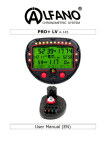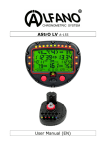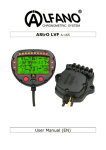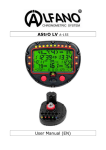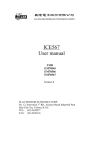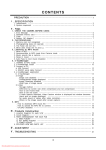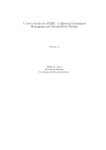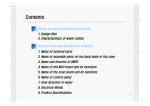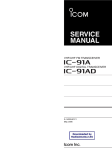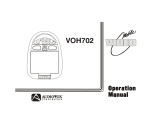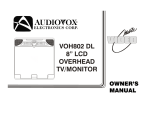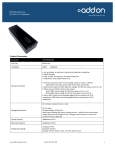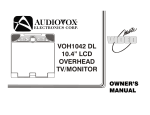Download BEC-Service Manual
Transcript
BENISON FB-388 BENISON FB-388 VHF FM TRANSCEIVERS Service Manual 2006-1-28 -1- BENISON FB-388 SPECIFICATIONS GENERAL . Frequency coverage . Type of emission . Number of channels . Power supply requirement . Current drain (approx.) : 144.0000-145.9875MHz : FM(FE3) : 99ch : 7.4 V DC (negative ground; supplied battery pack) : Transmit at High (4.0 W) 1.8 A, at Low (1.0 W) 700 mA : Receive rated audio 250 mA : stand-by 70 mA : ±0.001 % : -10°C~+60°C : 54(W)×112(H)×35(D) mm : 350 g . Frequency stability . Usable temperature range . Dimensions (projections not included) . Weight (with ant., BP-512) TRANSMITTER . RF output power (at 7.4 V DC) . Modulation system . Maximum frequency deviation . Spurious emissions . Adjacent channel power . Transmitter audio distortion : 4 W / 1 W (High / Low) : Variable reactance frequency modulation : ±2.5 kHz : 70 dB typical : 60 dB typical : Less than 3% at 1 kHz, 40% deviation RECEIVER . Receive system . Intermediate frequencies . Sensitivity . Squelch sensitivity . Adjacent channel selectivity . Spurious response rejection . Intermodulation rejection ratio . Hum and noise . Audio output power (at 7.4 V DC) : Double conversion superheterodyne system : 1st 38.850 MHz / 2nd 450 kHz : 0.18 µV at 12 dB SINAD (typical) : 0.25 µV at threshold (typical) : 65 dB (typical) : 70 dB (typical) : 70 dB (typical) : 40 dB (typical) : 500 mW typical at 5% distortion with an 8 ohm? load All stated specifications are subject to change without notice or obligation. 50 CTCSS TONES SQ. ( Hz ) NO. TONE NO. TONE NO. TONE NO. TONE NO. TONE 1 67.0 11 94.8 21 131.8 31 171.3 41 203.5 2 69.3 12 97.4 22 136.5 32 173.8 42 206.5 3 71.9 13 100.0 23 141.3 33 177.3 43 210.7 4 74.4 14 103.5 24 146.2 34 179.9 44 218.1 5 77.0 15 107.2 25 151.4 35 183.5 45 225.7 6 79.7 16 110.9 26 156.7 36 186.2 46 229.1 7 82.5 17 114.8 27 159.8 37 189.9 47 233.6 8 85.4 18 118.8 28 162.2 38 192.8 48 241.8 9 88.5 19 123.0 29 165.5 39 196.6 49 250.3 10 91.5 20 127.3 30 167.9 40 199.5 50 254.1 -2- BENISON FB-388 CONTROL AND CONNECTIONS 1. 2. 3. 4. 5. 6. 7. 8. 9. 10. 11. 12. 13. CONTROL DIAL VOLUME CONTROL /POWER SWITCH PTT BUTTON INTERNAL MICROPHONE FUNCTION BUTTON SQL BUTTON KEY PAD FUNCTION DISPLAY MIC JACK SP JACK INTERNAL SPEAKER ANTENNA TX INDICATOR -3- BENISON FB-388 CIRCUIT DESCRIPTION 1) Receiver System The receiver system is a double superheterodyne system with a 38.85MHz first IF and a 450kHz second IF. 1. Front End The received signal at any frequency in the 144.0000MHz to 145.9875MHz range is passed through the low-pass filter (L39, L38, L37, C159,C158, C122,C157,C121,C156 and C154) and tuning circuit (L19 and C203), and amplified by the RF amplifier (Q29). The signal from Q29 is then passed through the tuning circuit (L28.L27.L26) and converted into 38.85MHz by the mixer (Q28). The local signal from the VCO is passed through the buffer (Q34), and supplied to the source of the mixer (Q28). The radio uses the lower side of the superheterodyne system. 2. IF Circuit The mixer mixes the received signal with the local signal to obtain the sum of and difference between them. The crystal filter (FL3, FL2) selects 38.850MHz frequency from the results and eliminates the signals of the unwanted frequencies. The first IF amplifier (Q17) then amplifies the signal of the selected frequency. 3. Demodulator Circuit After the signal is amplified by the first IF amplifier (Q36), it is input to pin 16 of the demodulator IC (IC14). The second local signal of 38.4MHz, which is oscillated by the internal oscillation circuit in IC14 and crystal (X6), Then these two signals are mixed by the internal mixer in IC14 and the result is converted into the second IF signal with a frequency of 450kHz. The second IF signal is output from pin 3 of IC14 to the ceramic filter (FL1), where the unwanted frequency band of that signal is eliminated, and the resulting signal is sent back to the IC14 through pins 5.The second IF signal input via pin 5 is demodulated by the internal limiter amplifier and quadrature detection circuit in IC14, and output as an audio signal through pin 9. 4. Audio Circuit AF signals from the FM IF IC (IC14, pin 9) via the AF filter circuit (IC3, pins 12,13). The output signals from pin 14 are applied to the mute switch (Q16), are applied to the AF power amplifier (IC9, pin 4) after being passed through the [VOL] control (W2).The applied AF signals are amplified at the AF power amplifier circuit (IC1, pin 4) to obtain the specified audio level. The amplified AF signals, output from pin 10, are applied to the internal speaker (SP1) as the “SP” signal via the [SP-J] jack when no plug is connected to the jack. 5. Squelch Circuit A squelch circuit cuts out AF signals when no RF signals are received. By detecting noise components in the AF signals,A portion of the AF signals from the FM IF IC (IC14, pin 9) are applied to the squelch switches (Q19.20.21.22),the active filter section (IC14, pin 8) where noise components are amplified and detected with an internal noise detector.The active filter section amplifies noise components. The filtered signals are rectified at the noise detector section and converted into “SQI” signals at the noise comparator section. The “SQI” signal is applied to the CPU(IC8, pin 22). The CPU detects the receiving signal , and outputs an “AFB”signal from pin 39. This signal controls the mute switch (Q16) to cut the AF signal line. 2) Transmitter System 1. MICROPHONE AMPLIFIER CIRCUIT The microphone amplifier circuit amplifies audio signals with +6 dB/octave pre-emphasis characteristics from the microphone to a level needed for the modulation circuit. The AF signals from the microphone are applied to the microphone amplifier circuit (IC2C, pin 2). The amplified AF signals are passed through the low-pass filter circuit (IC1B, pins 5, 6). The filtered AF signals are applied to the modulator circuit after being passed through the modulation circuit. -4- BENISON FB-388 2. MODULATION CIRCUIT The modulation circuit modulates the VCO oscillating signal (RF signal) using the microphone audio signal. The audio signals change the reactance of a diode (D29) to modulate an oscillated signal at the VCO circuit (Q30).The oscillated signal is amplified at the buffer-amplifiers (Q31,Q32,Q33,Q35),. 3. DRIVE/POWER AMPLIFIER CIRCUITS The signal from the VCO circuit passes through the buffer (Q31,Q32,Q33,Q35),drive (Q27)and power amplifier (Q26)to obtain 4W of RF power (at 7.4V DC). The amplified signal passes through the antenna switching circuit (D11), and low-pass filter and is then applied to the antenna connector. The bias current of the drive (IC6) and the power amplifier (Q26) is controlled by the APC circuit. 4. APC CIRCUIT The APC circuit (IC6) protects the drive and the power amplifiers from excessive current drive, and selects HIGH or LOW output power. The signal output from the power detector circuit (L32,R177,RR95,RR144) is applied to the differential amplifier (IC6, pin 2.3), and the “PWC” signal from the expander (IC6, pin5), controlled by the CPU (IC8), is applied to the other input for reference. When the driving current is increased, input voltage of the differential amplifier (pin 2) will be increased. In such cases the differential amplifier output voltage (pin 7) is decreased to reduce the driving current. 3) PLL Synthesizer Circuit 1. PLL The dividing ratio is obtained by sending data from the CPU (IC8) to pin 14 and sending clock pulses to pin 15 of the PLL IC (IC13). The oscillated signal from the VCO is amplified by the buffer (Q31,Q34) and input to pin6 or pin11 of IC13. Each programmable divider in IC13 divides the frequency of the input signal by N according to the frequency data, to generate a comparison frequency. 2. PLL Loop Filter Circuit If a phase difference is found in the phase comparison between the reference frequency and VCO output frequency, the charge pump output (pin8,pin9) of IC13 generates a pulse signal, which is converted to DC voltage by the PLL loop filter and input to the varicap of the VCO unit for oscillation frequency control. 3. VCO Circuit A PLL circuit provides stable oscillation of the transmit frequency and receive 1st frequency. The PLL output compares the phase of the divided VCO frequency to the reference frequency. The PLL output frequency is controlled by the divided ratio (N-data) of a programmable divider.The PLL circuit contains the VCO circuit (Q25, Q30). The oscillated signal is amplified at the buffer-amplifiers (Q34, Q31) and then applied to the PLL IC (IC13). The PLL IC contains a prescaler, programmable counter, programmable divider and phase detector, etc. The entered signal is divided at the prescaler and programmable counter section by the N-data ratio from the CPU. The divided signal is detected on phase at the phase detector using the reference frequency. If the oscillated signal drifts, its phase changes from that of the reference frequency, causing a lock voltage change to compensate for the drift in the oscillated frequency. A portion of the VCO signal is amplified at the buffer-amplifier (Q34, Q31) and is then applied to the receive 1st mixer (Q28) or transmit buffer-amplifier circuit (Q32). 4) CPU and Peripheral Circuits 1. LCD Display Circuit The IC10 turns ON the LCD via segment and common terminals with 1/4 the duty and 1/3 the bias, at the frame frequency is 100Hz. 2. Display Lamp Circuit When the key is pressed, “H”is output form pin 24 of CPU (IC8) to the bases of Q2. Q2 then turn ON and the LED (D1.2.4.5.7.8) light. 3. DTMF Encoder The CPU (IC8) is equipped with an internal DTMF encoder. The DTMF signalis output from pin 8, through -5- BENISON FB-388 C60, and through the microphone amplifier (IC2), and is sent to the varicap of the VCO for modulation. At the same time, the monitoring tone passes through the AF circuit and is output form the speaker. 4. CTCSS Encoder The IC3 is equipped with an internal tone encoder, The tone signal (67.0 to 254.3Hz) is output from pin 18 of the IC3 to the varicap (D29) of the VCO for modulation. 5. CTCSS Decoder The voice band of the AF output signal from pin 9 of IC14 is cut by sharp active filter IC3 and amplified. The input signal is compared with the programmed tone frequency code in the CPU. The squelch will open when they match. . -6- BENISON FB-388 ADJUSTMENT PROCEDURES Note: It is assumed that the unit is supplied with a regulated 8.0 volts during the adjustment procedure. Do not use a metal screw driver to adjust the ferrite cores as it causes variations in the inductance whilst adjustments are being performed. Use of the wrong size trimming tools can cause damage to the cores. A plastic or ceramic trimming tool is recommended. ADJUSTMENT 1) Required Test Equipment The following items are required to adjust radio parameters: 1. Regulated power supply Supply voltage: 5~14V DC Current: 3A or more 2. Digital multimeter Voltage range: FS = Approx. 20V Current: 10A or more Input resistance: High impedance 3. Oscilloscope Measurable frequency: Audio frequency 4. Audio dummy load Impedance: 8 ohm Dissipation: 1W or more Jack: 3.5mm 5. SSG Output frequency: 200MHz or more Output level: -20dBu/0.1uV ~120dBu/1V Modulation: FM 6. Spectrum Analyzer Measuring range: Up to 2GHz or more 7. Power meter Measurable frequency: Up to 200MHz Impedance: 50, unbalanced Measuring range: 0.1W ~10W 8. Audio volmeter Measurable frequency: Up to 100kHz Sensitivity: 1mV to 10V 9. Audio generator Output frequency: 67Hz to 10kHz Output impedance: 600, unbalanced 10.Distortion meter/SINAD meter Measurable frequency: 1kHz Input level: Up to 40dB Distortion: 1% ~100% -7- BENISON 11.Frequency counter Measurable frequency: Up to 200MHz Measurable stability: Approx. ±0.1ppm 12.Linear detector Measurable frequency: Up to 200MHz Characteristics: Flat CN: 60dB or more Note Standard modulation: 1kHz ±2.5kHz/DEV Reference sensitivity: 12dB SINAD Specified audio output level: 200mW at 8 FB-388 Adjustment Mode High power adjustment mode 1. 2. 3. 4. 5. At same time push [3] key and [9] key. Rotate [VOL] to the power ON. Then press [7] key, Press the [6] or [9] key set the output power to the value closest to 4 W . When the PTT key is released, the output power at that time will be stored as the high power setting. Press the SQL key to return. Low power adjustment mode 1. 2. 3. 4. 5. At same time push [3] key and [9] key. Rotate [VOL] to the power ON. Then press [8] key, Press the [6] or [9] key set the output power to the value closest to 1 W . When the PTT key is released, the output power at that time will be stored as the low power setting. Press the SQL key to return. Modulation Adjustment STEP CONDITIONS ADJUST READINGS 1 Connect the antenna output via a suitable RF attenuator to a modulation analyzer ━ ━ 2 Apply 1000Hz at a level of 5.0mV to the microphone jack ━ ━ 3 Press the PTT switch W1 Modulation analyzer reading 1.5kHz (+/-0.2KHz) 4 Increase the level to 50mV W1 Modulation analyzer reading 2.5kHz (+/-0.1KHz) modulation signal -8- BENISON FB-388 Frequency Adjustment STEP CONDITIONS ADJUST 1 Connect the antenna output via a suitable RF attenuator to a Frequency counter ━ 2 Press the PTT switch W3 READINGS ━ Frequency counter: +/-0.2KHz SERVICING AND REPAIR RF RECEIVE CIRCUITS 1. Ensure that the transceiver has not been switched to the battery saving mode. 2. Carefully check that all connectors are in a good condition. Check that the power supply voltage(IC5) of the receiver circuit is approximately 4.5-5.0V. 3. If the correct gain is measured then check that the bias of Q25 or Q30 is Vs=1V and Vd=4.2V. Check the signal level at the collector of Q31 or Q34 the local oscillator output, the signal level should be around -10dBm and the spectrum purity should be good. TRANSMIT CIRCUIT 1. Carefully check that all connectors are in good condition and check that the power supply voltage is correct. 2. Using the frequency counter to check that the operating frequency is correct. If not, check whether the PLL is locked. If the PLL is unlocked, check the local oscillator circuit. If the PLL is locked, check that the RF output is correct. If not, check from Q31 Q32 Q33 Q35 Q27 Q26 stage by stage to assure that the signal levels are correct. First check the bias voltage of each stage and then try to find any voltages which are out of tolerance. VOLTAGE REGULATION CIRCUIT Apply 8.0 volts to the power input jack, Measure the collector voltage of IC5. The normal value should be approximately 5.0 volts. The voltage at the collector of IC5 should hold are approximately 5.0 volts. AUDIO OUTPUT 1. Connect a signal generator set to the required frequency at an output level of 1mV, deviated with a 1kHz tone and 1.5kHz deviation to the antenna socket. Connect a probe to pin 9 (the output pin) of IC14. If the transceiver is operating correctly a 1kHz sine wave should be present. 2. If not, then use the oscilloscope to check the second local oscillator to assure that it is operating correctly. A probe connected to the case of X3 or pin 16 of IC13 should detect the presence of a -9- BENISON FB-388 38.4MHz sine wave. If not, then X6 may have failed. 3. If a 1kHz signal is measured at pin 9 of IC14 then decrease the output level of the signal generator to 0.35uV. If the 1kHz audio signal disappears when the RF level is decreased to this level, then IC14 may be faulty. 4. If IC14 appears okay, then check IC1 are correct. Check for the presence of a 1kHz audio signal at the collector of the pin10. 5. Check pin 14 of IC3 to see if there is a 1kHz audio signal present. Check pin 10 of IC1 for a presence of a large 1kHz audio signal. If the audio output signal is too small or not present then IC1 may be faulty. CONTROL PROBLEM If the LCD display becomes faulty then check the drive IC10. - 10 - BENISON FB-388 PARTS LIST Part Type Designator Footprint C1 1000P C2 C3 1000P 1000P C4 1000P C5 C6 1000P 1000P C7 1000P C8 C9 1000P 1000P C10 1000P C11 C12 1000P 1000P C13 1000P C14 C15 1000P 1000P C16 1000P C17 C18 1000P 1000P C19 1000P C20 C22 1000P 1000P C23 1000P C24 C25 1000P 1000P C26 1000P C27 C28 1000P 1000P C29 1000P C30 C31 1000P 1000P C32 1000P C33 C34 1000P 1000P C35 1000P C36 C37 1000P 1000P C38 1000P C39 C40 1000P 1000P C41 1000P C42 C43 1000P 1000P C44 1000P - 11 - BENISON FB-388 C45 C46 1000P 1000P C47 1000P C48 C49 1000P 1000P C50 1000P C51 C52 1000P 1000P C53 1000P C54 C55 1000P 1000P C56 1000P C57 C58 1000P 0.01 C59 0.01 C60 C61 0.01 0.01 C62 0.01 C63 C64 0.01 0.01 C65 0.01 C66 C67 0.01 0.01 C69 100P C70 C71 1000P 0.1 C72 1000P C73 C74 15P 10U C75 10U C76 C77 10U 10U C78 10U C79 C80 10U 10U C81 10U C82 C83 10U 10U C84 10U C85 C86 100P 100P C87 100P C88 C89 100P 100P C90 100P C91 100P - 12 - BENISON FB-388 C92 C93 100P 100P C94 100P C95 C96 100P 100P C97 0.1 C98 C99 0.1 0.1 C100 0.1 C101 C102 0.1 0.1 C103 0.1 C104 C105 0.1 0.1 C106 0.1 C107 C108 0.1 0.1 C109 0.1 C110 C111 0.1 0.1 C112 0.1 C113 C114 0.047 0.047 C115 0.047 C116 C117 22P 22P C118 22P C119 C120 22P 22P C121 22P C122 C123 22P 5600P C124 5600P C125 C126 0.022 220P C127 220P C128 C129 220P 220P C130 1U C131 C132 1U 1U C133 1U C134 C135 1U 180P C136 200P C137 10U - 13 - BENISON FB-388 C138 C140 1U 0.22 C141 0.22 C142 C143 0.22 0.22 C144 0.22 C145 C146 0.22 100U C147 100U C148 C149 22U 1U C150 1U C151 C152 8200P 10P C153 10P C154 C155 10P 10P C156 10P C157 C158 10P 10P C159 10P C160 C161 470P 470P C162 470P C163 C164 470P 470P C165 470P C166 C167 470P 470P C168 470P C169 C170 10U 10U C171 0.1U C172 C173 0.1U 102P C174 47P C175 C176 47P 4.7U C177 4.7U C178 C179 17P 1P C180 1P C181 C182 1P 15P C183 12P C184 12P - 14 - BENISON FB-388 C185 C186 12P 12P C187 12P C188 C189 12P 12P C190 12P C191 C192 0.5P 0.5P C193 82P C194 C195 8P 18P C196 18P C197 C198 18P 18P C199 5P C200 C201 4P 4P C202 7P C203 C204 20P 20P C205 33P C206 C207 9P 1000P C208 1000P C209 C210 1000P 1000P C211 0.01 C212 C213 100P 100P C214 100P C215 C216 100P 0.1 C217 0.01 C218 C219 0.01 22U C220 1000P C221 C222 1000P 1000P C223 1000P C224 C225 1000P 1000P C226 1000P C227 C228 1000P 1000P C229 1000P C230 100P - 15 - BENISON FB-388 Part Type Designator Footprint D1 LED_Y D2 D3 LED_Y 1SS372 D4 LED_Y D5 D6 LED_Y A111 D7 LED_Y D8 D9 LED_Y A111 D10 A111 D11 D12 1SS356 HS277 D13 1SS356 D14 D15 A111 A111 D16 A111 D17 D18 A111 A111 D19 A111 D20 D21 A111 LED_G D22 LED_R D23 D24 N 3V D25 HVC375 D26 D27 HVC375 HVC375 D28 HVC375 D29 BB149 Part Type Designator Footprint FL1 FL2 LTC450E 38.85M FL3 38.85M Part Type Designator Footprint IC1 TA7368F IC2 IC3 NJM2902V CMX808 IC4 24WC08 IC5 IC6 XC6202P502 NJM2904 IC8 EM78P567 IC10 HT1621B - 16 - BENISON FB-388 IC13 IC14 M64082 TA31136 Part Type J1 Designator Footprint JACK (MIC) J2 SMD14P J3 J4 ANT JACK SMD14P J5 SP-J Part Type Designator Footprint K1 FUNC K2 K3 MONI PTT K4 RTW K5 POWER SW Part Type Designator Footprint L1 L2 102T 102T L3 102T L5 L6 102T 102T L7 102T L8 L9 102T 10UH L11 150N L12 L13 180N 2.2UH L14 2.2UH L15 L16 2.2UH 2.2UH L17 100N L18 L19 100N 100N L20 100N L21 L22 68N 470N L23 470N L24 L25 102T 102T L26 7T L27 L28 7T 7T L29 7T L30 7T - 17 - BENISON FB-388 L31 L32 1UH 301T L33 9T L34 L35 3T 2T L36 2.2UH L37 L38 4T 5T L39 5T L40 6T Part Type Designator Footprint Q1 Q2 5B1 2SC2712 Q3 2SC2712 Q5 Q6 DTA114 DTA114 Q7 DTA114 Q8 Q9 DTA114 DTA114 Q10 DTA114 Q11 Q12 DTA114 DTA114 Q13 5B1 Q14 Q15 5B1 2SK1588 Q16 DTA114 Q17 Q18 DTA114 DTA114 Q19 DTA114 Q20 Q21 DTA114 DTA114 Q22 DTA114 Q23 Q24 2SC4617 2SC4617 Q25 K52 Q26 Q27 R007 2SK2973 Q28 DUR Q29 Q30 DUR K52 Q31 R24 Q32 Q33 R24 R24 Q36 2SC5195 Part Type Designator Footprint - 18 - BENISON FB-388 R1 R2 47K 47K R3 47K R4 R5 47K 47K R6 47K R7 R8 47K 47K R9 47K R10 R11 47K 47K R12 47K R13 R14 47K 220 R15 220 R16 R17 330 330 R18 330 R19 R20 330 330 R21 330 R22 R23 330 10K R24 10K R25 R26 10K 10K R27 10K R28 R29 10K 10K R30 10K R31 R32 10K 10K R33 10K R34 R35 10K 10K R36 10K R37 R38 4K7 4K7 R39 4K7 R40 R41 4K7 560 R42 560 R43 R44 560 560 R45 100 R46 100 - 19 - BENISON FB-388 R47 R48 100 100 R49 100 R50 R51 100 100 R52 100 R53 R54 100 100 R55 100 R56 R57 100 100 R58 100 R59 R60 470 470 R61 470 R62 R63 470 2K R64 2K R65 R66 T10K 15K R67 15K R68 R69 3K3 3K3 R70 3K3 R71 R72 3K3 3K3 R73 3K3 R74 R75 3K3 0 R76 0 R77 R78 0 0 R79 0 R80 R81 0 0 R82 0 R83 R84 0 0 R85 2K7 R86 R87 2K7 100K R88 100K R89 R90 100K 100K R91 100K R92 100K - 20 - BENISON FB-388 R93 R94 100K 100K R95 100K R96 R97 100K 100K R98 100K R99 R100 1K 1K R101 1K R102 R103 1K 1K R104 1K R105 R106 1K 1K R107 1K R108 R109 1K 1K R110 1K R111 R112 1K 1K R113 1K R114 R115 1K 1K R116 1K R117 R118 1K 1K R119 1K R120 R121 220K 220K R122 220K R123 R124 220K 330K R125 330K R126 R127 10 47 R128 33K R129 R130 0 2K R131 120K R132 R133 33K 10 R134 10 R135 R136 22K 22K R137 470K R138 1M - 21 - BENISON FB-388 R139 R140 1M 1M R141 1M R142 R143 68K 180K R144 180K R145 R146 180K 180K R147 3K9 R148 R149 3K9 3K9 R150 1K5 R151 R152 1K5 1K8 R153 47 R154 R155 47 6K8 R156 2K2 R157 R158 2K2 2K2 R159 22 R160 R161 22 20K R162 33K R163 R164 33K 10K R165 10K R166 R167 10K 47K R168 47K R169 R170 100 3K3 R171 680 R172 R173 680 2K2 R174 47 R175 R176 47 150K R177 82K R178 R179 220 220 R180 56K R181 R182 330K 82K R183 180K R184 180K - 22 - BENISON FB-388 R185 180K Part Type Designator Footprint MC1 SP1 MIC(-58dB) 8ohm W1 W2 W50K 10K W3 50K X1 4M X2 32.768K X3 X5 16.8M C24 X6 38.4M - 23 - BENISON FB-388 MEMO - 24 - FB-388 BLOCK DIAGRAM MIC PTT SP W1 VOL IC1 TCXO 16.800MHz PLL IC IC13 IC9 LOOP FIL LOOP FIL AF AMP IC14 IF DET IC BPF FL1 VCO (Q30) VCO (Q25) Q19.Q20.Q21.Q22 SQL Q32 Q33 IC8 5V BPF L26.L27.L28 Q31 BPF 21.4MHz FL2.FL3 BUFF Q28 BUFF Q13 T5V Q14 R5V BUFF Q34 BUFF Q36 IF AMP T5V R5V Q35 PRE DRIVE IC6 Q29 RF AMP VCC Q27 PWR AMP L30.L40 BPF IC8 CPU LPF SQI AF AMP AF AMP AF REG Q1.Q6 AFB IC2 MIC AMP D6 RESET PTT JACK (SP) JACK (MIC) IC2D VOX AMP COM R5C T5C D11.D13 ANT SW IC4 EEPROM LPF LCD DRIVE IC10 ANT LCD KEYBOARD





























